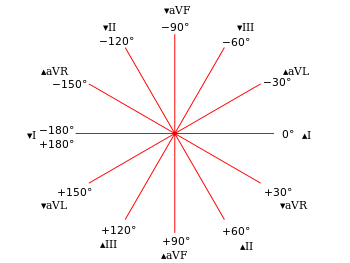Left axis deviation
In electrocardiography, left axis deviation (LAD) is a condition wherein the mean electrical axis of ventricular contraction of the heart lies in a frontal plane direction between −30° and −90°. This is reflected by a QRS complex positive in lead I and negative in leads aVF and II.[1]

The hexaxial reference system is a diagram that is used to determine the heart's electrical axis in the frontal plane.
Cause
Common causes of LAD include left anterior fascicular block (or hemiblock) and inferior myocardial infarction.[2][3] Less commonly LAD may be a normal variant, particularly in obese or stocky individuals, or it may be associated with Wolff–Parkinson–White syndrome or an ostium primum atrial septal defect.
See also
References
- Jenkins, Dean (1996). "The electrical axis at a glance". www.ecglibrary.com. Retrieved 2016-11-12.
- Lilly, Leonard (2006). Pathophysiology of Heart Disease. Lippincott Williams and Wilkins. ISBN 978-0-7817-6321-9.
- Kasper D, Braunwald E, Fauci A, Hauser S, Longo D, Jameson J (2005). Harrison's Principles of Internal Medicine (16th ed.). McGraw-Hill. p. 1314. ISBN 0-07-147760-8.
This article is issued from
Wikipedia.
The text is licensed under Creative
Commons - Attribution - Sharealike.
Additional terms may apply for the media files.